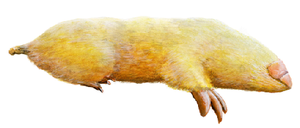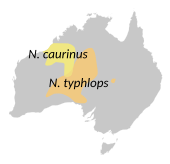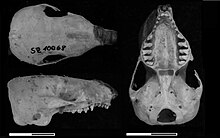Bag mole
| Bag mole | ||||||||||||
|---|---|---|---|---|---|---|---|---|---|---|---|---|

Bag garbage |
||||||||||||
| Systematics | ||||||||||||
|
||||||||||||
| Scientific name of the order | ||||||||||||
| Notoryctemorphia | ||||||||||||
| Kirsch , 1977 | ||||||||||||
| Scientific name of the family | ||||||||||||
| Notoryctidae | ||||||||||||
| Ogilby , 1892 | ||||||||||||
| Scientific name of the genus | ||||||||||||
| Notoryctes | ||||||||||||
| Stirling , 1891 |
Bag moles form the marsupial order Notoryctemorphia with only one family (Notoryctidae), one genus ( Notoryctes ) and two species: Large bag mole ( N. typhlops ) and small bag mole ( N. caurinus ). The relationship between these animals and the other marsupials is unclear; they are certainly a 50-million-year-old side line of the marsupials.
distribution
Bagmulls inhabit sandy desert areas in the interior of Australia . The Greater Bag Muck lives in large parts of the continent, while the Lesser Bag Muck is only found in a small area in northwestern Western Australia .
The Australian nature filmmaker Malcolm Douglas was the first to document the animal on photo and film.
description
In terms of size and physique, the pouch mole resembles the placental gold mole . They are around 9 to 18 cm long, with a short, hard tail. The color of the fur varies from white to pink to red gold. The physique of these animals is perfectly adapted to the burrowing way of life. The third and fourth toes of the forelimbs are enlarged like a shovel, the remaining fingers are small but have claws. The front and rear legs are so short that they are hidden in the fur and only the feet can be seen. The tail is stubby and surrounded by rough skin.
On the bridge of the nose there is a yellow horn shield with transverse ridges, which is used when digging. Small ear openings are located under the fur of the head, they can be closed by a fold of skin. The eyes are almost completely regressed and covered by muscles and skin. The neck vertebrae are fused together. This improves the stability during the thrusting digging movements.
Way of life
Bag moles do not have a completely subterranean way of life like the moles do. Rather, they “swim” through the sand, no deeper than 8 cm below the surface. They also don't leave any permanent tunnels, as the passageways immediately collapse behind them. In between they come to the surface for short stretches.
Bag moles are loners. They hardly make any noises, and if they do, then weak, chirping sounds.
food
The food of the pouch mole consists mainly of insect larvae. Insects and occasionally seeds are also eaten.
Reproduction
Little is known about the reproduction of the pouch mole. In males, the testicles are in the body. Females have a flat pouch that opens backwards. It is divided lengthways by a fold of skin and there is a teat in each half. Females dig permanent holes in which the offspring will probably be housed after the time in the bag.
threat
Both species were in 1996 by the World Conservation Union IUCN in the endangered Red List species as endangered ( Endangered ) classified. Since 2008, they have not been assessed due to insufficient data ( data deficient ).
literature
- Ronald M. Nowak: Walker's Mammals of the World . Johns Hopkins University Press, 1999 ISBN 0-8018-5789-9
Web links
- Endangerment level of the two species in the IUCN Red List of Threatened Species .

